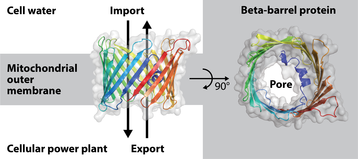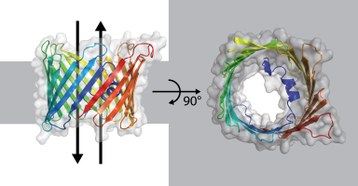Formation of pores in mitochondrial membrane elucidated
Freiburg, Jan 05, 2023
Model of the beta-barrel protein porin from baker's yeast found in the mitochondrial outer membrane. Illustration: Christophe Wirth
Mitochondria are considered to be the power plants of cells and are essential for human metabolism. Dysfunction in 40 percent of mitochondrial proteins are associated with human diseases, which is why mitochondria also play an important role in medical research. A previously unexplained process in the complex mitochondria was the formation of their barrel pores. These are located within the mitochondrial outer membrane and serve as a portal through which substances are exchanged between mitochondria and the cell water. Researchers at the University of Freiburg and the University of Kyoto/Japan have now been able to elucidate the guidance mechanism by which the pores are formed through structural and functional experiments. The study by the team led by Prof. Dr. Nils Wiedemann and Prof. Dr. Nikolaus Pfanner from the Faculty of Medicine and the Cluster of Excellence CIBSS at the University of Freiburg and by Prof. Dr. Toshiya from Kyoto Sangyo University has been published in the journal Nature Structural & Molecular Biology. "Barrel pores are essential for life, as they are indispensable for the exchange of substances within cells," explains Wiedemann. "Understanding them better is an important building block for basic cellular research."
Similarities to the wine barrel structure
It was already known that the barrel pores in mitochondria are made of a protein molecule that has to be folded up to 19 times through the outer membrane for this purpose. These so-called beta-strands, which span the outer membrane, are arranged in a circle like the longitudinal woods/staves of barrels used in wine production, so that a pore is formed in the mitochondrial outer membrane. Beta-barrel proteins are assembled by the sorting and assembly machinery (SAM) in the mitochondrial outer membrane.
Roles of Sam50 and Sam37
By purifying and elucidating for the first time a protein complex structure of the sorting and assembly machinery together with a beta-barrel protein during beta-barrel formation, it was proven that the last beta strand of beta-barrel proteins is first attached to Sam50 (a protein subunit of the sorting and assembly machinery) in the mitochondrial outer membrane. Then, the other strands are assembled one by one. In this process, the part of the protein chain of beta-barrel proteins upstream of the strands is important not only for their function but also for their assembly.
In contrast, the Sam37 subunit has a protrusion that extends into the mitochondrial outer membrane, around which the strands of the beta-barrel proteins are arranged in a circular fashion. Functional experiments in which the protrusion of Sam37 was removed showed that the protrusion is critical for ring closure of the beta-barrel proteins. "This allowed us to assign the Sam37 subunit a function as a cooper/barrel maker for the formation of the vital beta-barrel membrane proteins in our cellular power plants," Wiedemann explains.
Overview of facts:
- Originalpublikation: Takeda, H., Busto, J.V., Lindau, C., Tsutsumi, A., Tomii, K., Imai, K., Yamamori, Y., Hirokawa, T., Motono, C., Ganesan, I., Wenz, L.S., Becker, T., Kikkawa, M., Pfanner, N., Wiedemann, N., Endo, T. (2023): A multipoint guidance mechanism for β-barrel folding on the SAM complex. In: Nature Structural & Molecular Biology. DOI: 10.1038/s41594-022-00897-2
- Nils Wiedemann and Nikolaus Pfanner are group leaders at the Institute of Biochemistry and Molecular Biology and project leaders in the Clusters of Excellence CIBSS - Centre for Integrative Biological Signalling Studies and BIOSS Centre for Biological Signalling Studies as well as the Spemann Graduate School of Biology and Medicine at the University of Freiburg.
- About the Cluster of Excellence CIBSS: The Cluster of Excellence CIBSS – Centre for Integrative Biological Signalling Studies aims to gain a comprehensive understanding of biological signaling processes across scales - from the interactions of single molecules and cells to the processes in organs and whole organisms. The knowledge gained can be used to control signals in a targeted manner, and this in turn enables researchers not only to gain insights in research, but also to innovate in medicine and plant sciences.
Press images for download
 |
Illustration: Christophe Wirth | ||
 |
Illustration: Christophe Wirth |
Contact:
Prof. Dr. Nils Wiedemann
Institute of Biochemistry and Molecular Biology
Faculty of Medicine
University of Freiburg
Tel.: 0761/203-5280
Email: nils.wiedemann@biochemie.uni-freiburg.de
Sarah Brender
Office of Univerity and Science Communication
University of Freiburg
Tel.: 0761/203-95391
Email: sarah.brender@zv.uni-freiburg.de

